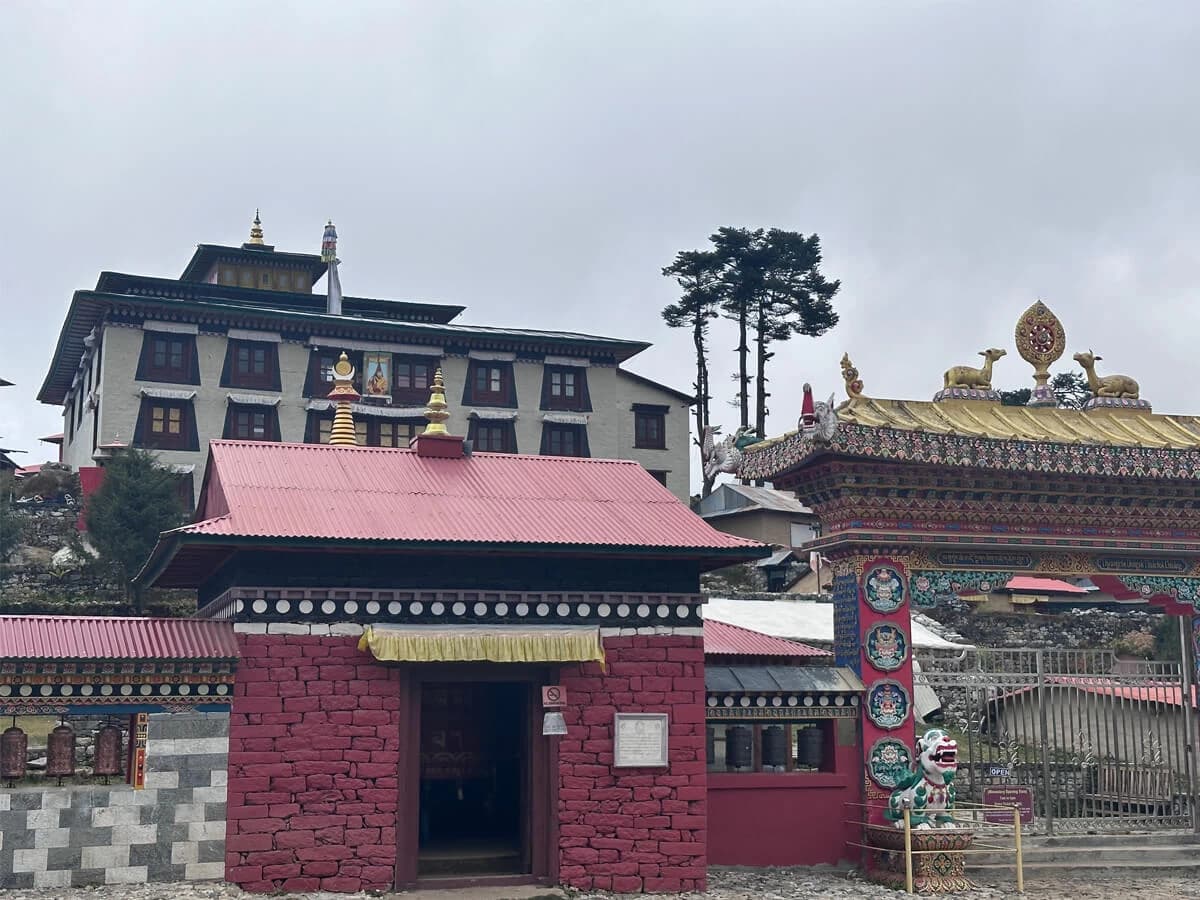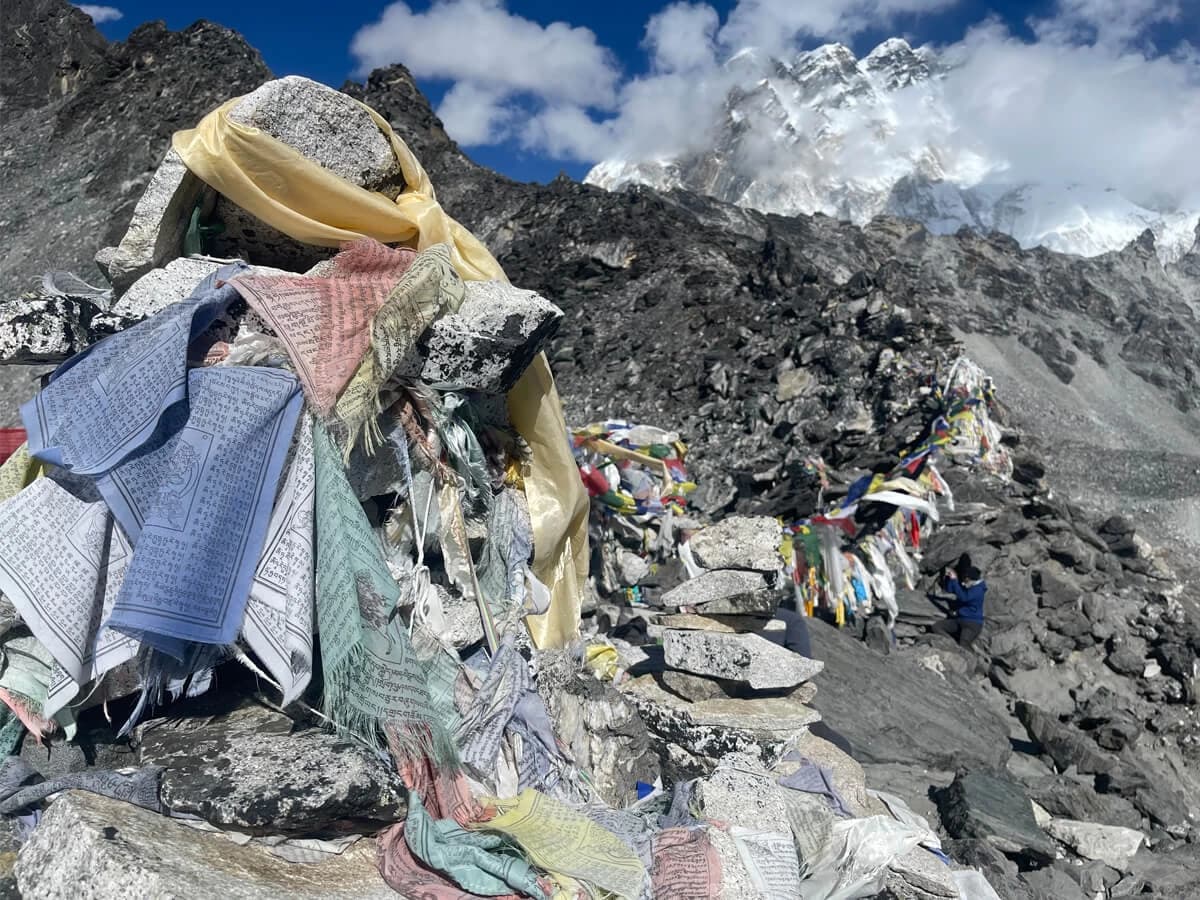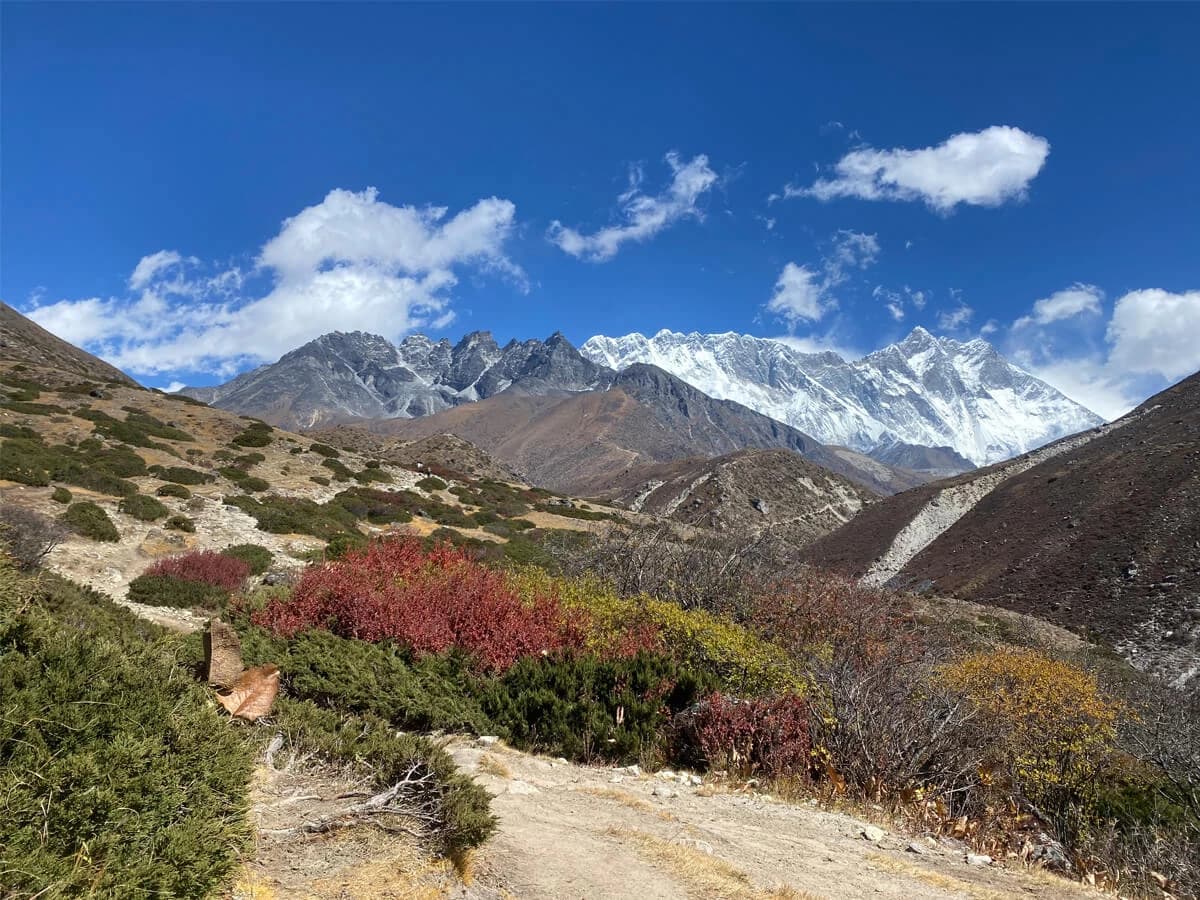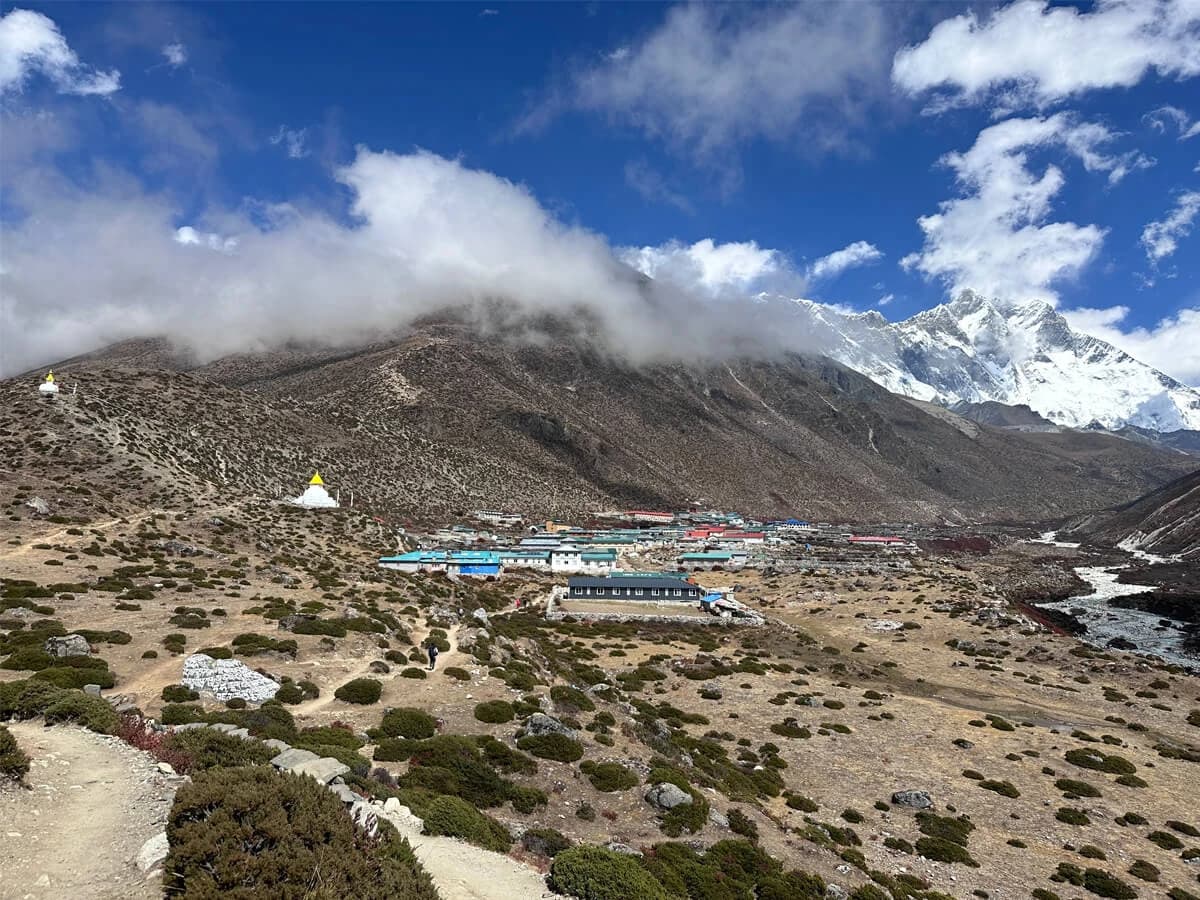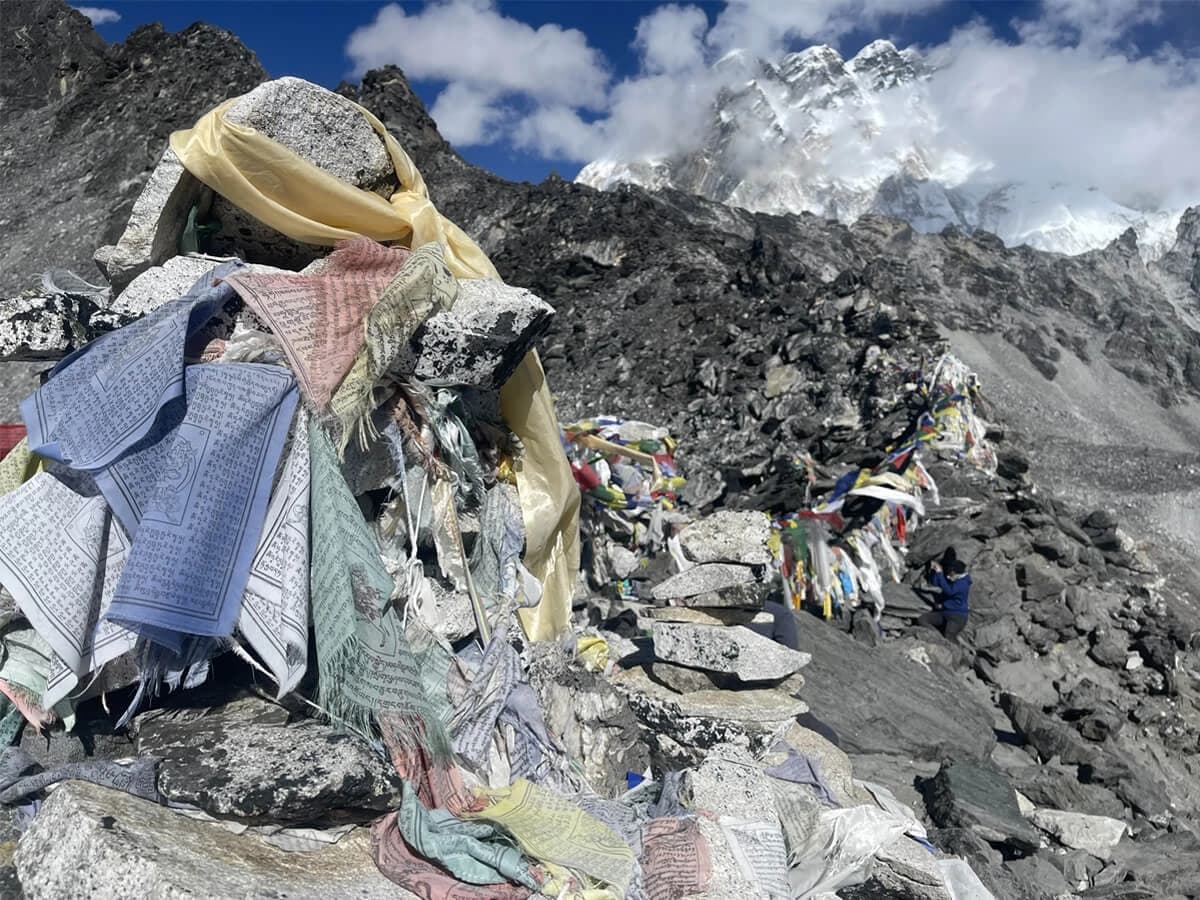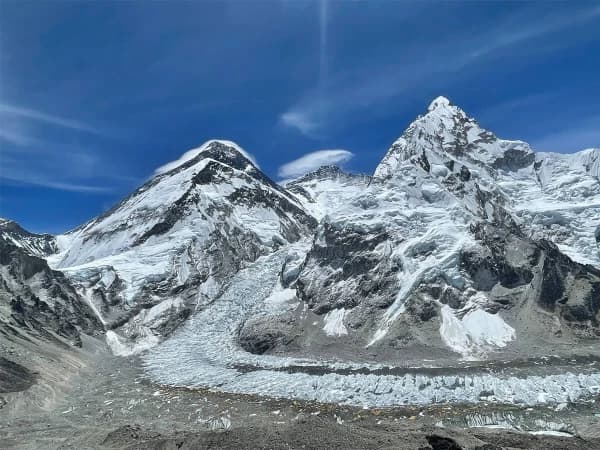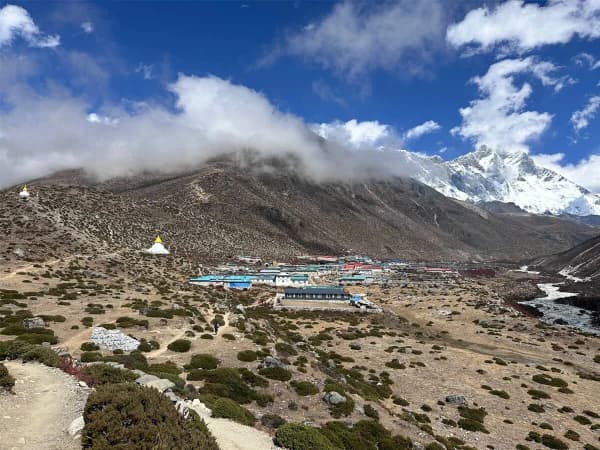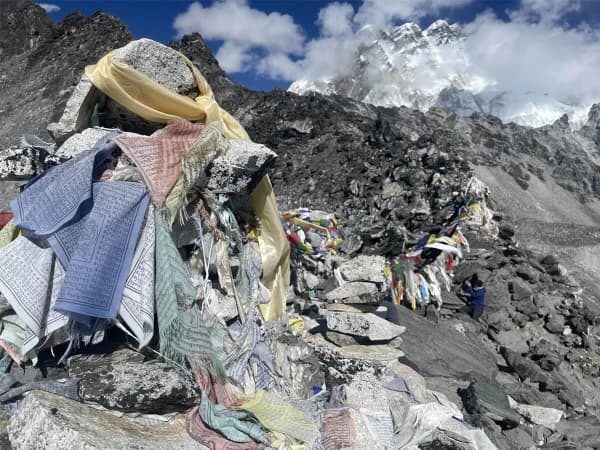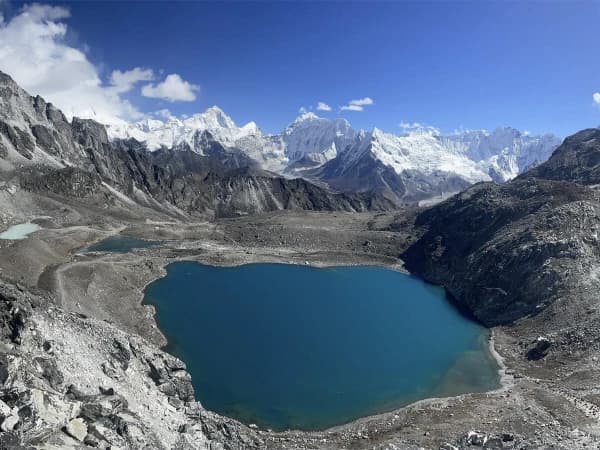Overview
Everest region is one of Nepal's most renowned tourist destinations. Most people want to go to the Everest region to explore the world’s tallest mountain. This is the ultimate Everest trekking experience for fit mountain walkers. The three-pass trek is an adventure and thrilling trek covering the over 5,000 meters of Kongma La, Renjo La, and Cho La. Although each pass covers the stunning views of mountains.
This 20 day’s Everest Three Passes Trek offers an incredible experience of the 5,000-meter three passes, as well as opportunities to see Lukla, Namche Bazaar town, the gateway and treading center of the Everest region, old Tengboche monastery, Sherpa culture, Gokyo Lake, and the world's highest mountain, Everest, 8,848.86 meters above sea level, and its base camp.
Highlights
- Trek an entire circuit of the Everest region.
- Explore the bustling Namche Bazaar.
- Mesmerizing views of the world’s highest mountain, Everest.
- Explore the Gokyo Lakes a series of turquoise-colored lakes nestled amidst the mountains.
- Climb to Gokyo Ri for panoramic views of the Everest massif including Mt. Everest, Cho Oyu, and Nuptse.
- Cross three tough and challenging 5,000-meter passes, Kongma La, Renjo La, and Cho La.
- Get the incredible experience of the mountain Everest base camp.
- Discover local Sherpa people's cultures.
- Get incredible golden sunrise and sunset views from the Kalapattar of the world's highest Mount Everest.
- Visit the old Tengboche monastery of the Everest region.
- Sightsee around the Gokyo village including Gokyo Lake.
Three Passes Trek in the Everest Region
The Everest Three Pass Trek 20 Days is an incredible tour across the Everest-Gokyo region that provides the best trekking experience. During this trip, you will see breathtaking mountain views, along with glaciers, historic valleys, and hard passes. This journey is ideal for bold trekkers who are determined to cross three of the highest passes, such as Kongma La (5,535 meters), Chola (5,360 meters), and Renjo La (5,385 meters).
Furthermore, crossing the three high passes while climbing to the three peaks of Gokyo Ri, Kalapathar, and Everest Base Camp adds to the trek’s uniqueness and attraction. This journey begins with a flight from Kathmandu to Lukla. You will trek through mesmerising towns: Lukla, Namche, Thame, Tengboche, Pangboche, Dingboche, and other equally magnificent areas.
The Sherpas, or natives, are well-known for their mountain climbing abilities. You will be able to immerse yourself in their unique culture and lifestyle. The Khumbu region also includes the Sagarmatha National Park, which is dedicated to safeguarding the varied flora and fauna of the area. Various exotic animals, such as musk deer, mountain goats, and snow leopards, can be found here. Along the route, you will witness several bridges, monasteries, and Chortens (stupas) with colourful Buddhist prayer flags that bring peace, compassion, happiness, and positivity. The best time to go on this trek is from March to May in the spring and September to November in autumn.
This trek is physically demanding, so you have to be physically fit and healthy to join in this trek because you have to cross 5,000 above passes, and it is not as easy as you thought. So be prepared before going on this trek, and even if you have previous trekking experiences, it will help you to trek three passes in the Everest region. Overall, this trek is an ideal combination of breathtaking scenery, unique culture, and exhilarating adventure that you won't want to miss.
If you have any questions or queries, feel free to contact us to know more about the trek. We would be glad to reply to you at any time.
Why do the Three Passes Trek in the Everest Region?
The Three Passes Trek is the ideal trek for every trekker, where you will have a challenging, exciting, thrilling adventure at the same time but a rewarding adventure for experienced trekkers. The Three Passes Trek includes all the major areas of the Everest and Khumbu region of Nepal, so we have designed such an amazing Three Passes Trek of the Everest Region, which provides you an incredible pass experience with a surrounding majestic glimpse of iconic peaks such as Kungde Ri, Mount Thamserku, Sundar Peak, Mount Ama Dablam, Mount Choltse, Mount Everest, Lobuche Peak, Mount Pumori, Mount Lhotse, Mount Tabuche, Island Peak, and several other named and unnamed peaks. Likewise, even if it is difficult to walk, trekkers will have magnificent Himalayan terrain experiences with each step. This three-pass trek takes you over 5,000 meters, passing across Renjo La, Cho La, and Kongma La passes. From here, you will witness stunning panoramic vistas of the snow-capped peaks, glaciers, and valleys.
On the one hand, your three-pass trip will be affordably priced with quality logistics services, and trekking in the Everest region will provide an opportunity to learn about Sherpa culture, known for its warm hospitality, colourful festivals, Buddhist tradition, history, livelihood, heritage sites (such as monasteries, stupas, and mani walls), the geography of the areas, flora, fauna, and settlement patterns. On the other side, the trek takes you through varied landscapes, from lush rhododendron forests to barren, high-altitude deserts, and trekking trails normally climb up and down, and in some sections, you need to climb through the rocky parts and snowy parts using crampons to cross the passes. During your three-pass trek, you will have plenty of time to adjust your body to high-altitude climates because it is not easy to cross the 5,000-meter passes, so you need to ascend gradually to avoid high-altitude sickness.
At last, successfully completing the Three Passes Trek is a significant achievement that will boost your confidence and leave you with lasting memories. To complete your trek, our company offers guided treks with experienced guides, assistance guides, and porters, ensuring a smooth and safe experience. Throughout your trekking trip, we provide comfortable lodges and teahouse accommodations and delicious meals along the trail as well as handle all necessary permits and arrangements, making the planning process hassle-free. While the Three Passes Trek is a challenging undertaking, it offers an unparalleled adventure through one of the world’s most stunning mountain regions. If you are an experienced trekker seeking a truly unforgettable experience, this trek is definitely worth considering.
Are you ready for the Everest Region Three Passes Trek? How to Prepare for the Journey?
Are you prepared to set out on the most amazing Himalayan journey? The Everest Three Passes Trek is a strenuous but hugely rewarding adventure that passes through some of the world's most breathtaking scenery. Whether you are an experienced or a beginner trekker, you should exercise effectively while you’re trekking. Being well-prepared is essential to a successful and safe trek. This thorough guide will assist you in preparing and is listed below:
Physical preparation
- Cardiovascular Fitness: To increase your endurance, regularly perform cardiovascular exercises like jogging, cycling, swimming, and running. By doing these exercises, you will improve heart and lung strength. They enable you to stroll for extended periods of time without experiencing fatigue. Make an effort to engage in aerobic activities three to five times per week. As your fitness level increases, you can progressively extend the duration and intensity of your sessions from shorter beginnings. Additionally, this workout makes it easier for your body to consume oxygen. When trekking at higher elevations, it is crucial. It might also be beneficial to incorporate interval training into your regimen, which alternates periods of high activity with rest. This gets you ready for the peaks and valleys of a trek, such as walking on level ground and ascending hills. Regular aerobic exercise will greatly simplify and enhance your trekking experience.
- Flexibility and Balance: Are you aware that other aspects of your trekking plan are just as crucial as flexibility? You feel liberated enough to overcome difficulties or take large strides with your muscles. You might start practicing stretches for your calf muscles or bowing to touch your toes. Stretching daily will help you avoid muscular fatigue and overcome the possibility of having tight muscles, especially after a long day trek. Flexibility and balance combine to make your movements fluid and under control. Yoga and other such practices are excellent because they simultaneously enhance both. It simultaneously helps you strengthen your core and stretch profoundly. Therefore, you will accomplish the goal of trekking without being hurt while aiming for flexibility and balance.
- Strength and Endurance: The trek consists of difficult terrain, rocky and uneven pathways, and steep ascents and descents. To combat these problems, it is essential to focus on building your leg muscles' strength and endurance through activities like hiking, stairs, climbing, or weightlifting. Incorporate strength training activities into your fitness regimen, emphasising the quadriceps, hamstrings, calves, and core muscles—muscles that are required during trekking. These muscle groups can be strengthened with exercises including calf raises, step-ups, lunges, and squats. Additionally, to replicate the circumstances you would experience during the trek, include frequent treks or hill training.
- Acclimatization: Acclimatisation to altitude is essential for the Everest Three Passes Trek. The trekking schedule is structured to include rest days and a gradual ascent to let your body acclimate to the higher elevations. On rest days, spend some time exploring the neighbourhood, going on quick treks, or just relaxing and drinking plenty of water. Pay attention to your body and let your guide or hiking team know if you experience any altitude sickness symptoms. Proper acclimatisation lowers the danger of altitude-related health problems and increases your chances of finishing the trek.
- Mental Preparedness: Because of the physical strain, altitude-related ailments, and decreased oxygen levels, trekking at high elevations can be emotionally taxing. Being mentally prepared is equally as crucial as being physically fit. To overcome obstacles in your path, cultivate a positive outlook, perseverance, and mental toughness. Long walking days, erratic weather, and possible discomfort from altitude are all things to prepare for. A healthier mental state during the hike can be achieved by being aware of the challenges and setting reasonable expectations.
Everest Region’s Three Passes Trek Packing Lists
Your packing list is one of the most crucial things you should consider before beginning this adventure. Trekking apparel and equipment are also necessary for a successful trek because they keep you protected and warm in high-altitude weather. Therefore, before spending money on trekking clothing, look for high-quality gear and equipment, which will help for the long term to use again and again. However, here we have mentioned clothing and equipment lists of the Three Passes Trek. This reminds you what to pack for your trek:
Clothing
Clothing is the essential thing for any adventure trekking that might be either woollen, cotton, or denim; these are the communal clothing materials. So you have to get comfortable clothes that absorb moisture.
While trekking, you must put on trekking clothes orderly so it will be easy for you to change layers or remove them as per weather conditions. The most important aspect is, it also depends on the trekking seasons, so you have to pack clothes according to that.
Inner Layers
The Three Passes Trek packing list must include breathable, quick-drying undergarments. These inner layers ought to be cosy and warm. Additionally, as you will be travelling in a chilly area, you should have at least two pairs of thermals. Sports bras that absorb perspiration are essential for female trekkers. The following is a list of inner-layer clothing needed for the trek:
- None Cotton underwear briefs (at least 5)
- Light thermal tops and down vests (at least 2 pairs)
- At least 2 sports bras (for ladies)
Lower Body
In the lower body layers, you need flexible, comfortable, quick-drying, convertible, and waterproof pants or trousers that easily absorb or dry sweat. It depends on you whether you want to choose full or half-trekking pants.
Additionally, wool or fleece is a typical material used in these trousers. Apart from that, you should also know some leggings and shell pants. Here we have mentioned essential lower-body layer clothes most required for the trek:-
- 1 pair of lightweight trekking pants or Gore-Tex pants
- 1 pair of convertible trekking pants
- 1 pair of trekking trousers
- 1 pair of thermal trousers
- 1 pair of waterproof shell pants
- 1 pair of fleece or wool trousers
- 1 pair of leggings
Upper Body Layers
In upper body layers, it should be quickly drying, flexible, and lightweight. So while buying, you have to buy washed and dried fast. Long-sleeved T-shirts that protect from sunburn and harsh windy weather are also important. Here we have mentioned below the upper body layers lists; they are as follows:
- 2 trekking trousers and shorts
- 1 fleece Wind-stopper jacket
- Waterproof jacket or Gore-Tex jacket
- Waterproof pants with breathable fabric
- Lightweight thermals
- Polypropylene shirts (half sleeves and long sleeves)
- Half-sleeve shirt
- Waterproof, breathable fabric jacket
- A down jacket
- Full-sleeve shirt
Footwear
It is one of the most important things that you need during trekking. The trails are rugged, steep, rocky terrain and have Cross Rivers, including three high passes, so well-maintained trekking boots are highly demanded in this Three Pass Trek of the Everest region. Which keeps your foot safe from injuries. For this trek, you are required to have suitable trekking boots, trekking socks, and crampons. Here we have mentioned footwear:
- Sturdy trekking boots
- 1 pair of slippers (use while staying at lodges)
- Gaiters (used in your trekking boots to protect boots from snow, stone, water, mud, and dust or to keep snow and debris out of your boots) should be lightweight.
- At least 4 pairs of normal and wool socks
- At least 5 pairs of trekking socks
- Crampons (for icy conditions)
Headwear
The head is one of the main parts of the body, so it should be kept safe from such a harsh cold weather condition. For this, you have to wear a wool hat to protect the head from the cold. Headbands, sunglasses, fleece hats, scarves, and beanies are some of the popular headwear required for the trek. Trekkers will also be protected from heavy rain, harsh sunlight, and freezing snow. For eyes, sunglasses are important to protect your eyes from harsh snow reflection, and for the face and mouth, use a bandana and scarves, and for the head, use fleece hats to keep your head warm.
- 100% UV-protected sunglasses
- UV-protected sunglasses
- Buff mask
- Woollen or synthetic hats or wide straw hats and caps (to protect the face from the sun)
- Headlamp with extra batteries and bulbs
- Bandana or headscarf
- Beanie
Hand Wears
Gloves must be worn as an in-hand layer to keep your hands warm and shield them from frostbite and cold, windy weather. So fleece gloves, lightweight poly-liners, and wool are the most popular gloves. You can also use mittens, as gloves might not be enough in cold conditions. Here we have mentioned some gloves that you need for this trek; they are as follows:
- 1 pair of poly liner gloves or thick gloves
- 1 pair of lightweight woollen gloves
- 1 pair of mittens
- Hands hand warm
- 1 pair of Gore-Tex gloves
Miscellaneous
Headlamps, batteries, reusable water bottles, water purification tablets, thermoses, trekking poles, raincoats, headphones (avoid noise disturbance), trekking bags, hiking backpacks or daypacks (40-50 litres), personal first aid kits, adapters, chargers, power banks, dry fruits, nuts and chocolates, sun protection cameras with chargers and extra batteries, etc.
Toiletries
Toilet paper, deodorant, shampoo, wipes, soap, wet tissue, toothbrush/toothpaste, hand sanitizers, moisturiser, sunscreen, lip balm, etc.
Important Document (Passport)
A passport is necessary to carry while you are trekking in any tourist destination in Nepal. At every checkpoint, it is required before entry into areas.
Note: By following these guidelines and preparing thoroughly, you can increase your chances of having a safe, enjoyable, and unforgettable experience on the Everest Three Passes Trek. Remember the journey is as important as the destination, so savour every moment of this incredible adventure.
What to Expect
This tough, thrilling Everest circuit trek will take you up to 5000 meters passes, and it is not as easy as you thought. For this trek, you need to prepare well because there are steep areas and rocky sections, and you are used to long, consecutive days of walking steep, boulder-strewn trails where the use of hands is essential to scramble upwards over rocky steps. Although this trek leads you over remote high passes, crossing the rugged terrains and snow sections.
Get the Three Passes Trek Service with Sherpa Summits
We, Sherpa Summits, specialize in crafting unforgettable trekking experiences for both domestic and international adventures in Nepal. Our dedicated team is committed to providing exceptional support throughout your trekking trips. From acquiring essential permits and arranging transportation to handling every logistical detail, we ensure a seamless experience tailored to your preferences.
Enjoy the epitome of quality service at an affordable price with our Everest Region Three Passes Trek Packages. Whether you’re embarking on a solo adventure or exploring the Himalayas with family, friends, or a partner, your safety and satisfaction are our top priorities. Our expert guides, assistant guides, and trustworthy porters are fluent in English and other languages, guaranteeing effective communication and cultural exchange.
Customize your Everest Region Three Passes Trek to align perfectly with your desires. Select your preferred departure date, group size, and daily itinerary. We welcome trekkers of all ages, as long as you possess the necessary physical and mental fitness. Rest assured, there are no hidden costs involved, and you will receive transparent pricing for your trek.
Embark on the adventure of a lifetime with Sherpa Summits. Our Everest Region Trek bookings for 2025 and 2026 are now open. Don’t hesitate to contact us for any inquiries or to start planning your dream Himalayan expedition.
